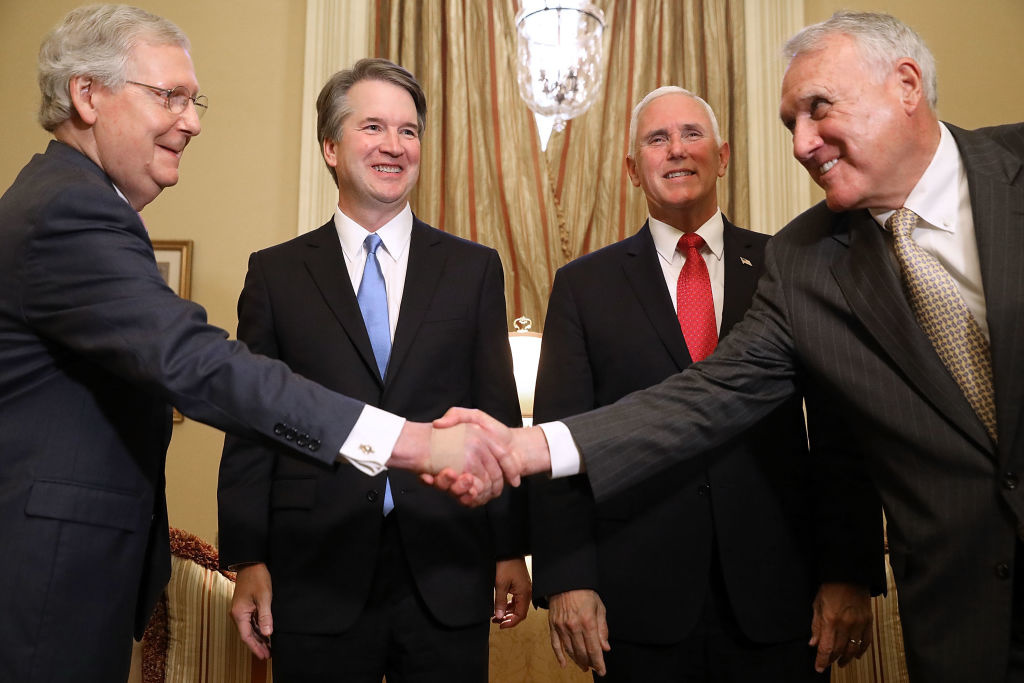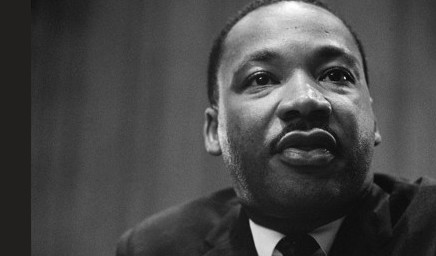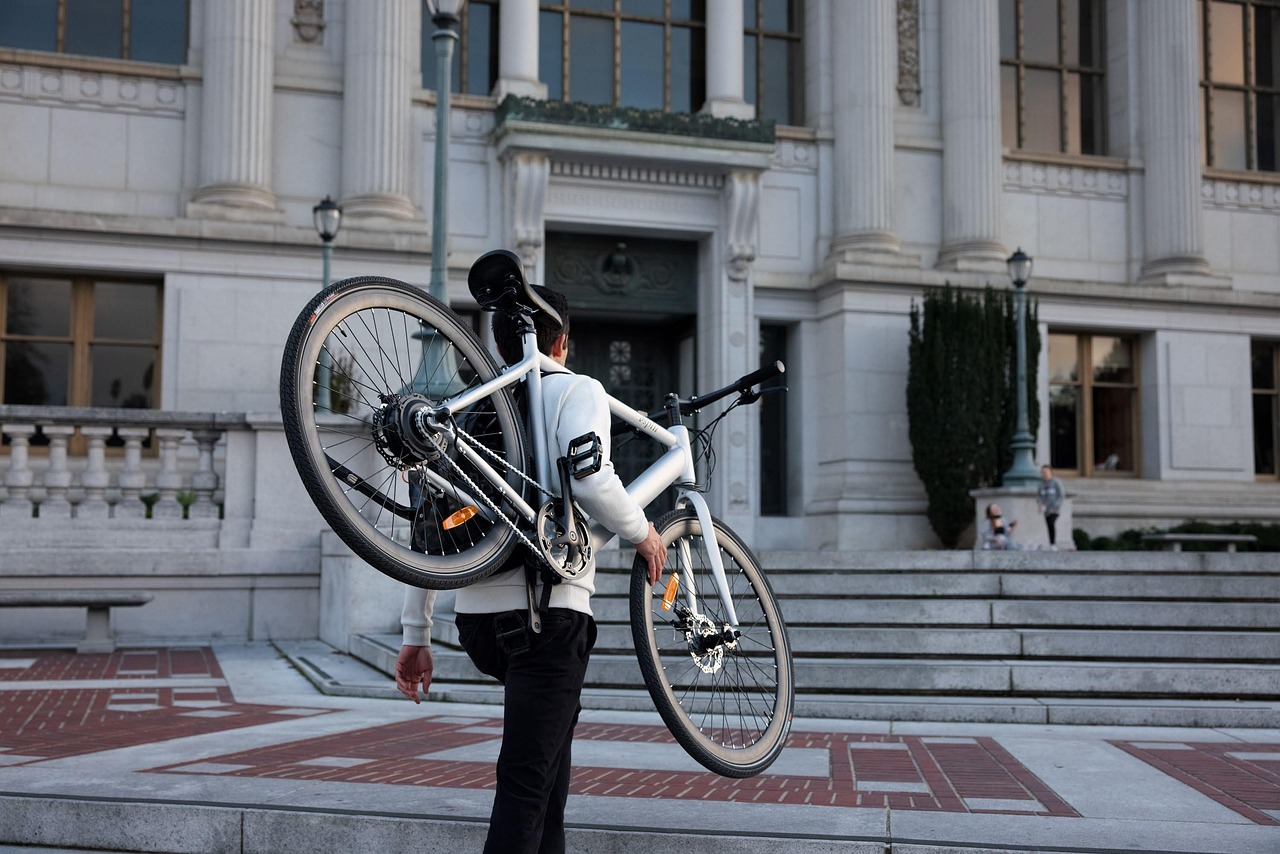When a storm hits, it can be difficult to remember everything that came before. After the revelations of the past week regarding allegations of sexual assault against Supreme Court nominee Brett M. Kavanaugh, the relative calm that was the previous months of the confirmation process seem like hazy half-memories.
Yet, in light of where the political gaze of the nation now finds itself directed, perhaps it’s time to ask, in the spirit of The Talking Heads, “How did we get here?” How did a man accused of sexual assault end up receiving a lifetime nomination to one of the most powerful institutions in America? Answering that question will require traversing the interconnected and exclusive ranges of the right-wing political machinery, where dark money and faceless groups lay their hands on the scales of our civic life. Yet, in the end, the question of how we got here is one with a relatively simple answer and one that strikes at the heart of a vast range of the illnesses that seem to be ravaging the body politic. We are here, and we are here with Brett Kavanaugh because a small group of wealthy people wanted us to be.
On July 9th in the East Room of the White House, Judge Brett M. Kavanaugh of the D.C. Circuit was officially unveiled as President Trump’s nominee to the Supreme Court. It was a sedated Trump who showed up to emcee the big reveal that day –– the incarnation of the 45th President who is shuffled out to read a script at grand occasions of state such as this, lest his free-wheeling, ad-libbing alter-ego debase the few civic rituals that have survived his first year in office. Trump dutifully sang Kavanaugh’s praises: “Judge Kavanaugh has impeccable credentials, unsurpassed qualifications and a proven commitment to equal justice under the law,” he assured the American people, squinting into the light of the teleprompter. His detachment seemed palpable, but not in the way that repeating the kind of boilerplate political language that comes so unnaturally to him usually appears. This was the detachment of a man uninvested in the grand spectacle of tension, power, and pomp that surrounded him, and, in a simpler previous life, would have been his to conduct. This was Donald Trump, trapped hosting a reality show he wasn’t controlling, put on by producers he despises; a show where the contestants were pre-selected and the winner decided in advance.
Prior to the upending effect of the public disclosure of the sexual assault allegations levied at Judge Kavanaugh by Christine Blasey Ford (the consequences of which, at time of writing, are yet to be fully borne out), the confirmation hearings had been mostly marked by the kind of aesthetic grandstanding that has come to form the majority of our contemporary political discourse. This was particularly true of the contribution of the Democrats on the Judiciary Committee, who struggled to form a single substantive counter-argument against what had appeared to be a confirmation secured on the strength of a brute mathematical reality. Despite bouts of laser-sharp questioning from Kamala Harris on women’s rights and Mazie Hirono on the judge’s view on Native Americans, as well as slightly less laser-sharp bouts of Cory Booker tweeting links to his Dropbox account, asserting, in the guise of a liberal Alex Jones, that he “has the documents”, the broad Democratic counter-argument during the confirmation hearings was a simple one. Brett Kavanaugh is Donald Trump’s justice, and, as Donald Trump is bad, he should be denied confirmation on account of being bad.
Yet, looking at the breadth of the Democrats’ campaign against Kavanaugh’s nomination, one can’t help but think that the bulk of their strategy would not have changed regardless of who won this season of The Judicial Apprentice, as though there were already a hymn sheet prepared for everyone to sing from with a space to write the name of whoever was eventually nominated. The plan until the recent revelations appears to have been to attack Kavanaugh as an extension of Trump personally, rather than as someone who poses a specific and pressing threat to certain ideals. That one-size-fits-all communications strategy was made a little too publicly apparent immediately after the East Room unveiling when, in the proud Democratic tradition of reliable competence, the DNC tweeted out a rousing call to #StopKavanaugh that made one small error: the picture of the judge they used was of Thomas Hardiman (another rumored candidate for the seat). Yet, perhaps the Democrats can be forgiven for approaching Kavanaugh as a factory-made, hard-right jurist because, in fact, that’s exactly what he is.
In early 2016 –– a time that now seems to belong to another political epoch –– then-candidate Donald Trump took the unusual step of publishing a list of his potential Supreme Court picks. The list, which, at the time, appeared unlikely to ever actually become relevant, was designed by then-campaign lawyer Don McGahn to assure the right-wing establishment that his ideologically erratic candidate could be relied upon to deliver them a justice who would swing the court in their preferred direction for generations. After the election, the list made the seamless transition from speculative fiction to official White House policy, as Neil Gorsuch jumped from paper to robe under the careful guidance of now White House counsel McGahn and became the newest Associate Justice of the Supreme Court. The rest of the names on the list; which included DNC-canon justice Hardiman, evangelical Catholic cult aficionado Amy Coney Barrett, William Pryor –– a man who thinks that decriminalizing homosexuality was made a bit too hastily, as well as Kavanaugh, could not have been more palatable to the conservative donor base if they’d written it themselves. This is probably because, essentially, they did.
The Federalist Society, founded in 1982 at the height of the Reagan-era conservative fever dream, is a network of lawyers and jurists who work to combat the perceived ‘liberal’ tendencies of America’s judicial system. They advocate the so-called ‘originalist’ and ‘textualist’ approaches to jurisprudence most famously espoused by former Supreme Court Justice Antonin Scalia, the product of an ill-fated crossover between the Scarlet Letter and The Sopranos whose most famous contributions to the judicial corpus involved compromising the ability of states to regulate firearms and enshrining the rights of corporations to spend unlimited, unaccountable sums of money to influence elections. The group is backed by the kind of people one would expect would be interested in enshrining a judicial philosophy that can essentially be boiled down to ‘Mad Max, but the NFL is still on’; the Koch brothers, Exxon Mobil, Google, and the Knights of Columbus are all donors. It should come as no surprise then that the Federalist Society Executive Vice President Leonard Leo was the co-author of Trump’s Supreme Court list, and that the shadowy organization has been one of the strongest lobbyists in Congress for both Gorsuch and Kavanaugh’s confirmations.
In many ways, the establishment of the Republican party has gotten away with their role in enabling the Trump Presidency –– whether it be the donors like Islamophobic blob-fish Sheldon Adelson, who so quickly moved to pour resources into his campaign after condemning his lack of support for Israel; or the #NeverTrumpers like Jeff Flake, who has made himself a CNN-ebrity by shouting “how dare you, sir!” at the President on the floor of the Senate before sitting down and voting 83% of the time for his policies. For these people, the litany of horrors unleashed by the Trump administration is either their stated policy goals or acceptable casualties. Their primary objections to Trump are largely aesthetic –– they worry that the President’s propensity for free-association bigotry is saying the quiet part of their ideology loud in a way that might attract undue attention and resistance. Yet they endure it and will continue to endure it for however long the President remains in office because he has signed up to give a life appointment to those who whistle at a much less audible pitch.
Brett Kavanaugh is the apotheosis of the right-wing, corporatist establishment’s vision of a justice. In his confirmation hearings, he gave answers to direct questions that were so evasive they were practically quantum. He replied that he “could not provide his views” 53 times to written questions, providing a rationale of response that seemed to be limitless only in defining what he was not, not what he is. This is all that The Federalist Society and their boosters in Congress and the business world desired. Trump could morph into a cloud of sarin and visit a playground so long as their ideological aim of pushing the Supreme Court to the right is achieved, and so they have instituted a system that has ensured they have complete control over the trajectory of that process. This is the mechanism that resulted in such an inanimate Trump appearing in the East Room that day, a mechanism with one singular focus –– to place in the President’s hand a cue card with “Brett Kavanaugh” written in big bold type. Considering the subsequent trajectory of the confirmation process, perhaps Donald Trump is glad he didn’t take that producer’s credit.
Seamus McGuigan is a writer and academic studying Critical Theory and Comparative Literature at NYU. Find him on Twitter: @seamusmcguigan.
- Here’s a List of the People Who Made This Happen – Liberty Project ›
- Kavanaugh’s Confirmation Moves Forward – Liberty Project ›
- Key Republicans on Senate Judiciary Committee Condemn Trump’s Remarks as Investigation Closes – Liberty Project ›
- 3rd Kavanaugh Accuser Comes Forward Before Trial – Liberty Project ›





